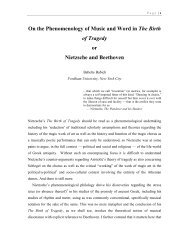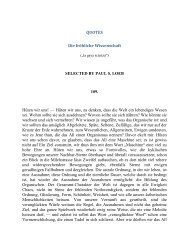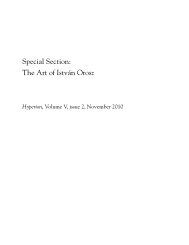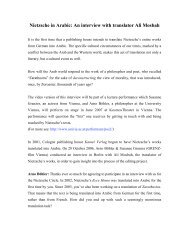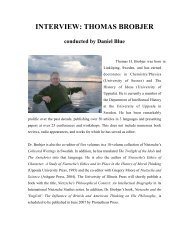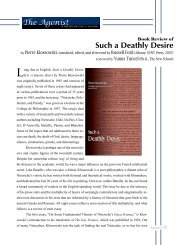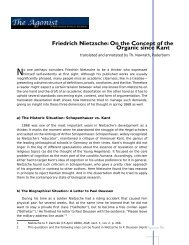Hyperion - Nietzsche Circle
Hyperion - Nietzsche Circle
Hyperion - Nietzsche Circle
Create successful ePaper yourself
Turn your PDF publications into a flip-book with our unique Google optimized e-Paper software.
suppose if somebody would tell me what to do, I would do it” (5). Yet, during<br />
the first part, he repeatedly falls asleep during conversations or shows himself<br />
inattentive. On the few occasions when he is about to take initiatives, he is<br />
“rudely” pushed back into a corner, told to sit down, not interrupt, “be silent or<br />
leave the room” (138). Every episode stops with his being either dismissed or<br />
forgotten.<br />
This series of failures is reversed in the second part. Malcolm and Melba fall<br />
in love and decide to get married. The episodes that follow come in logical<br />
sequence as the development of this decision: virility ordeal (tattooing), sexual<br />
initiation (at Madame Rosita’s), experience of loss (Gus dies), reunion and<br />
marriage, Malcolm’s illness (leading to Melba’s betrayal), his death. The plot<br />
unfolds smoothly—too smoothly, suspiciously so.<br />
Such unusual treatment of the main character leads us to another reading<br />
of the text, underlying the surface reading. On a superficial level, Malcolm<br />
is simply another character in a conventional narrative, just like Mr. Cox and<br />
Gus; on a deeper level, however, he is a “character in the making,” part of<br />
a work in progress, and the two intermediaries who animate him, Mr. Cox<br />
and Gus, are comic figures of would-be writers. At the beginning, Mr. Cox,<br />
as would-be “author,” is haunted with the idea of a character not yet clearly<br />
defined in his mind: a Shakespearean name, a princely orphan, an engaging<br />
youth, altogether a promising character—hence the sumptuous surroundings.<br />
For the moment, either the “author” has no idea of a plot, or he is in no hurry<br />
to spoil his pleasure, so he toys with the possibilities opened to him by this<br />
fresh new character he has conjured up in his mind—hence the golden bench<br />
and the boy’s “waiting” look, the lack of precision concerning him, his ageless<br />
look, “as if he had always been this height and would continue to be” (7). We<br />
understand that he has always been what he is now, he has a “charmed” life,<br />
which is not subject to the laws of nature but to the requirements of art.<br />
“HIGHLY CRITICAL”<br />
Cox and Gus correspond to different stages of artistic creation, the drafts and<br />
the definitive version. They also serve as warnings against opposite pitfalls of<br />
fiction writing. Behind Mr. Cox and Gus, the real narrator may have an ulterior<br />
motivation.<br />
Mr. Cox is presented as “the most famous astrologer of his period” (1). We<br />
are not told what period that is, and even if the following developments<br />
ascertain that Mr. Cox is not to be relegated to remote times, the choice of<br />
the words “his period,” the choice of the profession attributed to him (“People<br />
still study the … stars!” Malcolm exclaims, surprised, p. 5), all this contributes<br />
to associating him with obsolete practices. Under his patronage, ambitious<br />
literary projects are launched. Malcolm begins as a romance and goes on<br />
33 <strong>Hyperion</strong>—Malcolm, or the Charmed Life of Books



